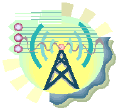Welcome to Handiham World.

Experiencing a CME
Remember last week's praise of the 10 meter band and the great DX conditions? Well, it's way different this week as the HF communications conditions have been tanked by a CME, or "Coronal Mass Ejection" from the sun.
I subscribe to a service from Spaceweather.com that provides me with a timely email about such solar events. On Monday, the day of the solar event, I was able to communicate on most of the HF bands quite well early in the day, but by mid-afternoon it was clear that something was happening. Sure enough, the email had arrived in my inbox, alerting me to the fact that a CME event had occurred:
"A coronal mass ejection (CME) hit Earth's magnetic field on Oct. 24th around 1800 UT (2 pm EDT). The impact strongly compressed our planet's magnetosphere and may have exposed geosynchronous satellites to solar wind plasma. Mild to moderate geomagnetic storms are possible in the hours ahead as Earth's magnetic field continues to reverberate from the hit."
Later in the evening on Monday I checked in with a group of friends on 1.902 MHz. It was 20:00 Central Daylight Time, and after sunset. Normally the 160 meter band would be really starting to open up that time of the evening, but conditions were so bad that sky wave communications were almost non-existent. Ground wave contacts were possible, and because several of us live within the range of ground wave communications, we were able to carry on a conversation. It was clear that not everyone knew what was happening, but by this morning the news had hit the popular media, with stories about the Northern Lights being observed even in the southern United States, a rare occurrence. Displays of the Northern Lights are common in the far north, as you might expect, when matter and radiation are ejected from the sun in the direction of Earth reach and disrupt the planet's magnetosphere. CME events are actually quite common as the sunspot cycle climbs to maximum, and there may be several each day. However, not all of them are as strong as this week's, nor are they all directed toward Earth. You can find out much more about CME events on Wikipedia or Spaceweather.com, but for our purposes we simply need to know that solar weather can bring a temporary halt to effective sky wave propagation.
It is tempting for those of us who have experienced multiple solar cycles as amateur radio operators to assume that most everyone will know why they turn on their HF radios and find comparative silence. There may be odd swishing sounds or hissing. Tuning around can yield more "birdies" (mixer products generated within the radio) than actual signals. We now have lots of new Technicians and Generals who have never been in this situation. That reminds me of the time when I was a new General and had never experienced the effects of a CME. It was a time of many sunspots, good DX, plenty of activity on the bands, and contacts with low power were "easy pickings". Imagine my thought processes when I switched on the receiver (we had separate transmitters and receivers in the late 1960's unless we had lots of money) and there was nothing but a gentle hiss. I immediately assumed that the antenna was disconnected - that's exactly what it sounded like, so it was a reasonable thing to check. When that idea fizzled, I actually took a hike out into the back yard to look at the antenna. It was till up there in the air, feedline connected, looking fit as ever.
This was a real head-scratcher!
Back inside I went to sit down and puzzle it out. RF gain, check. Antenna switch, check. All vacuum tubes in the receiver lit up, check. Broadcast stations coming in on medium wave, check. Eventually I must have talked with a fellow radio club member and gotten the lowdown on solar weather events like that one, but it always stuck with me that I felt that the antenna must not have been connected - that's how bad it was. You can well imagine a new ham today experiencing the same thing with this week's solar weather and thinking that they are either doing something wrong or they have some kind of an equipment or antenna problem.
So what do you do about it?
This is simple, and the method preferred by lazy operators: Just wait and do nothing. Band conditions will slowly improve, though it may take several days. You can have fun keeping an informal log of stations you hear on the various bands, perhaps even charting the return to normal conditions band by band, starting with 160 or 80 meters, where sky wave will return quickly, often within 24 hours. It will probably take longer for activity to return on bands like 10 meters. By yesterday 75 meters had cleared up pretty well and regional nets were back in operation.
For Handiham World, I'm...


